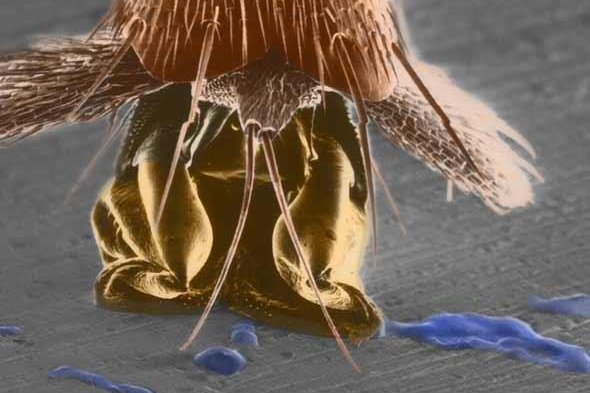A closeup shows the liquid trail left by an insect foot in the process of unsticking. Photo Walter Federle/Cambridge
CAMBRIDGE, England, Oct. 7 (UPI) -- Like most insects, stick insects can traverse vertical surfaces. Unlike geckos and tree frogs, which use dry friction to adhere to vertical surfaces, stick insects have wet feet.
Previously, scientists assumed the liquid excreted through their feet was key in adhering to the vertical surface. But new research out the University of Cambridge suggests stick insects instead use their liquid to unstick their feet.
"It has generally been assumed that the fluid on their feet must be involved in helping insects like stick insects adhere to a surface by capillary and viscous forces -- in the same way that a beer glass will stick to a glass table if it's wet on the bottom," David Labonte, a zoology researcher at Cambridge, said in a press release. "But our research shows that the fluid is likely used for something else entirely -- it may even help insects unstick their feet."
Labonte is the lead author of a new study on stick insect adhesion, published this week in the journal Soft Matter.
Labonte and his colleagues tested various adhesive pads -- simulations mimicked the adhesive feet and movements of stick insects -- on glass plates. After sticking and unsticking the pads at various speeds, and analyzing the results using the theory of fracture mechanics, researchers determined only a dry foot explained the adhesion of stick insects.
When they looked at dry and wet adhesive pads, they found liquid offered no adhesive benefits. So, what is the liquid used for?
Researchers suggest the liquid helps the insects release their feet when they need to get up and go. Adhesives like tape often leave behind a sticky residue. By lubricating their release, researchers say the stick insects likely guard against losing bits of their feet as they unstick themselves.
Scientists first noticed liquid on the feet of flies in the 17th century, not long after the microscope was invented. Now, they know why.
But the answer to the ancient question also has potential applications today and in the future.
"Understanding how insects control adhesion could have applications where adhesion is needed in a dynamic context, for instance in the production of small electronic devices, where it's necessary to pick up and place down tiny parts with ease and accuracy," said researcher Walter Federle.















